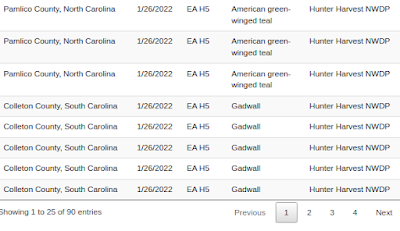
#16,549
In yesterday's blog on HPAI H5N1 in Europe, and in North America, I mentioned that while there were local media reports of HPAI and LPAI H5N1 in multiple states (including Virginia, Georgia, North & South Carolina) that the USDA only showed 3 confirmed cases (see yesterday's chart below), all in the Carolinas.

2022 Highly Pathogenic Avian Influenza
Last Modified: Feb 4, 2022
Through its ongoing wild bird surveillance program, APHIS collects and tests large numbers of samples from wild birds in the North American flyways. It is not uncommon to detect avian influenza in wild birds, as these viruses circulate freely in those populations without the birds appearing sick.
The recent detections of this strain of Eurasian H5 avian influenza in wild birds serve as an early warning system for bird owners in the U.S. to review and stay vigilant about their biosecurity practices to protect poultry and pet birds from avian influenza.
Table Key
a Specimens detected by the NAHLN H5 assay were further tested by a developmental real-time RT PCR targeting the Eurasian lineage goose/Guangdong H5 clade 2.3.4.4b. "Date Detected" indicates the date when a positive detection was obtained by the developmental RRT PCR targeting the Eurasian lineage goose/Guangdong H5 clade 2.3.4.4b.
b EA = Eurasian; AM = North American; the EA H5 (2.3.4.4) viruses are highly pathogenic to poultry.
c Virus lineage, subtype, and pathotype per cleavage site analysis are determined from sequence data direct from the sample or virus isolate. An incomplete subtype indicates either 1) the specimen is pending virus isolation and/or sequencing results, or 2) the specimen was detected by the developmental H5 RRT PCR targeting the Eurasian lineage goose/Guangdong H5 clade 2.3.4.4b but could not be further characterized, often due to a low level of virus or viral RNA present in a given sample.
d NWDP = UDSA Wildlife Services National Wildlife Disease Program
While the Eurasian HPAI H5 virus currently only poses a very low level of threat to public health, it is already wreaking havoc with poultry producers in Europe, and Asia, and - for the first time since 2016 - could seriously impact North America's poultry industry.



